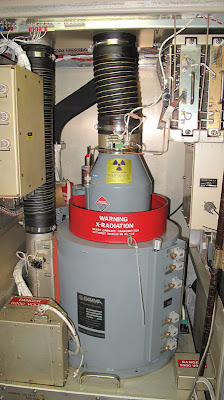The Icebreaker Mackinaw is, as its name suggests, a US Coast Guard ice breaking ship that was built in, and assigned exclusively to the Great Lakes. It served a distinguished, 62 year career that just ended in 2006. As such, it contains a very interesting mix of technology spanning the entire period from dynamo motor-generators to a modern fiber optic data network.
If you've ever visited large ships like the aircraft carrier Midway or the battleship Missouri, you'll immediately notice the similarity between them and the Mackinaw. Although only a fraction of the size of the large warships, the icebreaker nearly all the same amenities, just fewer of them. Standing in one of her two large engine rooms, you feel dwarfed by massive, locomotive-sized engines and generators spanning multiple decks below the waterline. Even though it is only a fraction of the size of most warship museums, it can still take hours to explore everything it has to offer.
Soon after the ship was decommissioned and replaced with a newer model, it local hams volunteered and joined the museum staff. On our visit, we met with Chuck, N8DNX, the president of the Charlevoix, Cheboygan, Emmet Counties Public Service Communications Organization - CCECPSCO for short, who maintain the club station W8CCE
Thanks to their diligence, CCECPSCO has established a permanent amateur radio station aboard the ship using some of the ships original HF/SSB antennas and radio gear. They have also installed a 2 repeaters on board, one UHF and one VHF, under the club station callsign W8AGB.
 | |
| RT-8000 HF transceiver |
 |
| Our hosts, N8NXP and N8DNX |
 |
| Radio repair room |
CCECPSCO is also registered as a 501c, non-profit organization. Donations are welcome and are tax deductible. If you ever get a chance to visit Michigan, make sure Mackinaw City is on your itinerary and the Icebreaker Mackinaw on your must-do list. If you're like us, you'll love it!
 |
| AA7BQ at the HF desk |
Click here to see 40+ additional photos from inside the Mackinaw.














